|
|
The Southend area, due to its varied habitat, has many bird species that can be seen all year round if you know where to look (if you don't, see our personal guided tour page). Below are some common and less common species that can be found at most times of the year. Most of these birds you will have to get out and look for as they are not our regular garden birds. We have provided information on each bird that will help you with identification. If you do go out looking for these birds, don't forget to email us and tell us of your sightings.
Avocet (Recurvirostra avosetta)
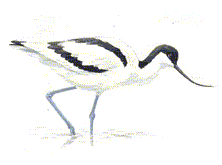 |
The avocet (42-45cm) is a boldly patterned bird with black and white plumage. It has a black patch which covers the crown to just below the eye, nape and upper hind neck. The rest of the bird is brilliant white with black patches on the wings. Most distinctively, the avocet has a slender upturned black bill and long blue-grey legs. In flight the long neck projects forwards and the legs protrude from the tail. Juveniles are coloured similarly to the adults but tend to be dull brownish rather than black and early on have mottled white upper parts.
The avocet's call is a fluty 'kloot'. If disturbed it will repeat an anxious yelping note 'kleep, kleep....' and at a large colony the arrival of a predator will result in a chorus of these calls.
A good place to start looking for the avocet would be Two Tree Island (western end).
|
Bearded Tit (Panurus biarmicus)
 |
The name 'bearded' is slightly misleading as the adult male has distinct black 'moustaches,' which contrast with its grey head and white throat. Upperparts are a rich tawny-chestnut with black, cream and white markings on the wings. Underparts are paler with striking black under tail-coverts . Females and immatures have plain brown heads and lack the black under tail-coverts, shape and behaviour distinctive. Young birds are more golden, with black backs and tail sides.
Adults measure about 16.5cm of which 7cm is the tail and in flight the long tail is fanned and twisted giving a characteristic flight action. Individuals or groups tend to fly low over the tops of the reedbeds, calling, before dropping down suddenly.
The call is distinctive and memorable: a metallic 'ching' or 'ping' used when perched or in flight and given in chorus by flocks. An excitement call - a hard tik, repeated is also used.
Bearded Tits can be found amongst the reeds in Wat Tyler Country Park in Pitsea if you have some patience.
|
Brent Goose (Branta bernicla)
 |
A small goose (56-61cm), barely bigger than a mallard. A short-necked, stocky bird, it has an overall dark appearance. All races have head, neck and upper breast black with adults having a white neck patch on both sides. They also have white underparts from legs to tail with a black-edged white tail and white rump. The dark-bellied race Branta bernicla bernicla has a slate-grey back and a dark grey belly, the light-bellied race B. b. hrota has a dark brown back with a pale brown belly, and the American race B. b. nigricans has a dark brown back and belly with pale flanks. Juveniles lack the white neck patch and have white wing stipes which they retain until adult.
They are often noisy on water and when disturbed as a flock giving a nasal, 'rronk-rronk' call.
A good place to see Brent Geese is around Two Tree Island during the winter or from Wakering Stairs |
Bullfinch (Pyrrhula pyrrhula)
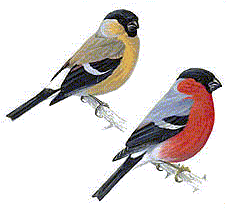 |
The bullfinch (15cm) is a stocky bird with a stout bill, black cap, grey back, white rump and a white bar on its black wings. The male has bright rose-red underparts while the female's are pinkish-grey in the female. Juveniles resemble a female without a black cap. It is secretive in habit and is usually located by its piping call or the flash of its pure white rump as it flits from cover to cover. Flight is undulating.
The call note is a low, rather sad, piping 'deu' or 'deu-deu' with considerable carrying power. There is no proper song but between late February and the end of August both sexes, at times, give a low, broken, piping warble of poor and crackly quality.
Perhaps the most difficult to find as numbers of these birds have dropped drastically in recent years and the bird itself is usually quite secretive. Hadleigh Country Park is probably a good place to start looking. The helpful Essex Rangers who manage the park will be able to advise you.
|
Chaffinch (Fringilla coelebs)
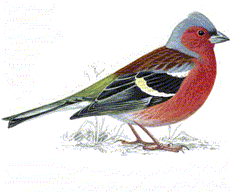 |
The size of a house sparrow, but thinner and with a longer tail. It has a slightly 'peaked' head, and like all finches, it has a short, triangular-shaped beak. In flight, it is recognisable by the double white wing-bar and white sides to the tail. The male has a pinky-red front and red on the side of the head. The crown and neck are blue-grey. The female and juvenile are much more sparrow-like - grey-green above and greyish-white below but they both have white wingbars, all though not so obviously as the male.
It is largely a ground-feeder and has a distinctive walk, with short steps and a nodding of the head. When perched it sits quite upright.
The cheerful song is a characteristic sound of spring consisting of a series of loud notes which accelerate and end with a flourish. Its rhythm is often compared to that of a bowler at cricket running up and bowling. Its most distinctive calls are a clear 'chink' which is given by both sexes when perched and when in flight the call is a soft 'choop'. A more confusing call is the so-called 'rain-call' which is best described as 'huit' but can vary.
Hadleigh Country Park has a good number of feeders in the Chapel Lane car park, these feeders always have a good number of Chaffinch around them.
|
Chiffchaff (Phylloscopus collybita)
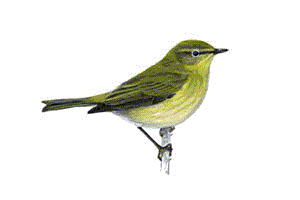 |
Most people hear a chiffchaff before they see it. It's one of the first familiar sounds of spring and to make it memorable, the bird sings its name 'chiff chaff, chiff chaff' over and over again. The male sings it from late March until the end of the spring, as it tries to attract a mate, get a territory and stop other males from taking it over.
The best places to look for chiffchaffs are woods and areas with lots of bushes. You can usually see them flitting about from branch to branch in spring before the leaves come out on the trees. After that, they are much harder to spot and you have to rely on hearing them to identify them.
The one common bird that is most often confused with the chiffchaff is the willow warbler. They look very similar, except that the chiffchaff has darker legs. But the songs are very different: that 'chiff-chaff' call, with one note higher than the other, is the real giveaway.
|
Coal Tit (Parus ater)
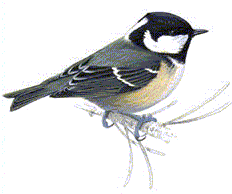 |
The smallest member of the tit family, at only 10.5-11.5 cm long, the coal tit is most readily recognisable with its glossy black cap with a distinctive white patch on the nape of its neck. A bold black bib at the throat gives way to a greyish-white belly and breast. It has olive-grey upperparts and two white wingbars.
Young birds have a yellowish colour to their cheeks and underparts.
Hanningfield Reservoir is probably the best place for this declining bird. The Essex Wildlife Trust can give you some help on seeing them. |
Cormorant (Phalacrocorax carbo)
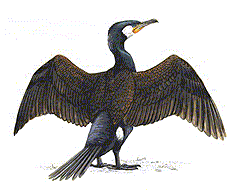 |
A large, heavy bird (80-100cm) with a long, hooked bill, long neck and goose-like appearance in flight. Adults are completely black apart from a bronze gloss on the wings and a white cheeks and throat. Breeding birds also have white thigh-patches which they use for display. A few white plumes may be seen on the loosely crested nape formed of elongated feathers. Outside the nesting season adults are much duller, and lose most of their white. Young birds are brown with whitish underparts.
In flight they fly in loose groups but occasionally almost make a 'V' formation, enhancing the goose-like silhouette. They fly with steady wing-beats and occasional glides and even soar in warm weather. The thick neck is often held kinked in flight, rather than fully extended, accentuating the reptilian appearance.
The bill is held at an upward angle when they are swimming and at a distance they could be confused with divers, which are very white underneath in winter. When perched on rocks or branches they often hold their wings outspread.
Could be confused with its close relative the shag but distinguished by the adult shag's lack of white and the overall heavier appearance and larger bill of the cormorant. The shag also has a faster wingbeat in flight.
The best views of Cormorant locally can be had from Wakering Stairs and the Fleet area. If you want to see them in close up then a trip to Hanningfield Reservoir would be a good choice.
|
Corn Bunting (Emberiza calandra)
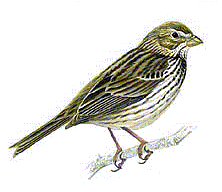 |
The corn bunting is the largest of the buntings (18cm), streaky, brownish, dumpy and somewhat bigger than a sparrow. The heavy head and bill, rather neckless appearance, large, dark eye in a rather pale face, and lack of white in the tail distinguish it from other buntings.
Often found in flocks in winter, during the breeding season it is often found singing on wires, telegraph poles and tops of bushes. Males sing, head thrown back, in almost every month of the year, and at any time of day. The song is an accelerating rattle with a metallic tone suggesting a jangling bunch of keys, Calls include a loud and rather liquid 'quit' sometimes repeated as a short phrase 'quit-it-it'.
The male pursues rivals or prospective mates low over cornfields. Its flight is heavy and bounding, with fluttering wings, and the males tend to distinctively dangle their legs during display flight. Good numbers of Corn Bunting can usually be seen along the MOD road at The Fleet in Wakering. Two Tree Island in winter can also be a good place to look.
|
Cuckoo (Cuculus canorus)
 |
Most of the UK's cuckoos arrive from Africa in April, although the earliest may arrive in late March. The first to arrive are the males who begin to advertise their presence with their familiar 'cuck-oo' calls. Care should be taken not to confuse a distant collared dove's call with a distant cuckoo as they can sound surprisingly similar.
If you hear a cuckoo calling then look out for it perched in a tree, on a fence or in flight. It looks rather like a bird of prey when flying, with pointed wings and a long tail. A cuckoo's body is pale grey and the underside is white with dark barring. When perched and calling it will raise and fan its tail, also waving it slowly from side to side.
Females look just like males but have a different call. It is a laughing, bubbling call, which is most frequently given after egg-laying and so is heard in May and June. |
Goosander (Mergus merganser)
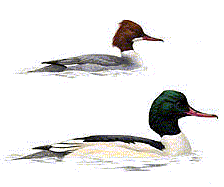 |
The largest of the sawbill family (58-66cm) they sit low in the water with characteristically long bodies. The drake is unmistakable with green head, long red bill, black back and pinkish white body. Female, eclipse male and juvenile have a distinct dark chestnut head and upper neck with an indistinct crest, a white chin, red bill, pale lower neck and grey-brown body. The similar female red-breasted merganser has an obvious ragged crest, a less contrasting division between dark head and pale neck, and a less well-defined white chin.
In flight they look long with a rapid wingbeat and large white wing patches. The similar red-breasted merganser has a white wing patch with a clear dark bar across it. When flying close by, a humming noise from the wings can be heard.
Hanningfield or Abberton Reservoir in winter would be the most likely places to see these birds.
|
Hen Harrier (Circus cyaneus)
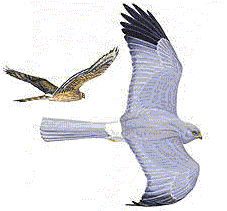 |
The hen harrier is one of three species of harrier which breed in the UK. Fairly large birds of prey, harriers have large wings in relation to their body, and long tails enabling them to sustain flight by being very buoyant. They tend to soar at heights of 100m or more and have spectacularly aerobatic displays in the spring. Hen harriers are typical of the family and tend to glide with wings held in an shallow 'V' when searching for food low over the ground.
There are very striking differences in colour between the male and female hen harrier. The male is pale grey and at a distance may appear gull-like but has broad, black wing-tips that are very distinctive. Its underparts are white and its grey back and tail are separated by a clear white rump. The brown female (about 120cm wingspan) is larger and heavier than the male (only about 100cm wingspan) and is dark brown with buff underparts, streaked dark brown. The dark back and dark-banded tail are separated by a bright white rump. Juvenile hen harriers of either sex look much like adult females but have shorter wings and tails and some are lighter or more tawny on their underside. Both juveniles and females are known as 'ringtails'.
The best place without a doubt to see the Hen Harrier is from Haven Point along Wakering Stairs during the winter. |
House Martin (Delichon urbica)
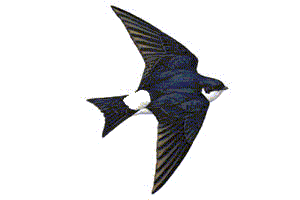 |
House martins are among the earliest migrants, arriving in the middle of March from Africa. One simple way of telling them apart from swifts, swallows and sand martins is to look for their bright white rump in flight - none of the others has this.
House martins live close to people; in fact, so close that they nest on people's houses in the place where the roof joins the wall. They make their nest using hundreds of little balls of mud, that they stick together to form a cup-shaped nest. Later in the summer, if you see martins flying back to their nest, you might see the youngsters, poking their heads out of the hole at the top.
Not only are house martins some of the first migrants to arrive, they are also among the last to leave. Sometimes, house martins are still seen in November, although you would be very lucky to see one that late in the year. |
Lapwing (Vanellus vanellus)
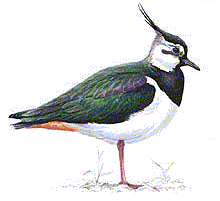 |
A strikingly crested and boldly patterned wader, about the same size (28-31cm) as a pigeon. The head is black and white with a short, stubby bill and a wispy, erect crest. The back and the wings are greenish black with white tips to the outer feathers and the underparts are mostly white with a black breast band. Adult breeding birds also have a black throat, in winter it is white. The rump is white and the undertail is cinnamon.
In flight they appear black and white and fly with distinctive flapping wingbeats, enhanced by the wings being sharply kinked at the 'wrist'. The flight silhouette is characteristic; the broad, rounded wings and shortish, blunt tail give it an appearance unlike any other British bird. The spring display flight is tumbling and erratic, rolling from side to side, climbing and diving, zigzagging and turning through 180 degrees .
The lapwing has various calls but the most familiar is its alarm call of 'peeawee' from which it derives its familiar name of peewit.
A trip to The Fleet in Wakering will give you good views of these birds. |
Linnet (Carduelis cannabina)
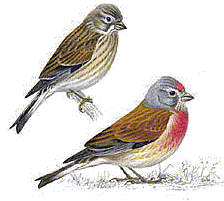 |
The linnet (13.5cm) is a slim, attractive and lively finch, smaller than a sparrow. In the breeding season the male is quite magnificent with a crimson crown and breast, a grey head with white throat, a bright chestnut-brown mantle and white edges to primaries and tail feathers. In winter he loses his grey head and crimson colour, becoming duller, with a streaky breast - rather like the female and juvenile. The flight is fast and undulating, often in tight, bouncing and noisy flocks.
When breeding, the birds perch openly on the tops of low bushes from where the male sings his very melodious song, with twittering, whirring sequences interspersed with fluted notes. A pair will often perch together and chatter to each other before flying off. Flocks can be very vocal in flight, giving a twittering call.
Wakering Stairs or the old tip alongside The Fleet will usually produce a Linnet or two.
|
Long-tailed Tit (Aegithalos caudatus)
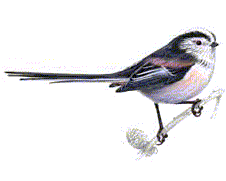 |
The long-tailed tit has a distinctive appearance, often unflatteringly known as a 'ball on a stick'. The adult is 13.5 cm 14.5 cm long, with a white crown and a black stripe a little above the eye. The black and white rump is mirrored by the upperparts, although the wings have a distinctive pink band. The long, black tail is rounded off with white outer feathers, and the throat, breast and underparts are all white, with a pink wash on the undertail. The legs are black.
The juvenile has a sooty-black face, its tail is clearly shorter and its body lacks the distinctive pink colour.
Long-tailed tits can often be heard before they are seen. Their, high 'see-see-see' calls, and lower 'tupp, tupp' notes, are quite distinctive.
Gunners Park in Shoeburyness or Wat Tyler Country Park in Pitsea will give you your best chances of seeing this small bird. Long-tailed Tits can always be seen in family groups.
|
Marsh Harrier (Circus aeruginosus)
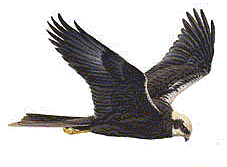 |
It can be recognised as a harrier by its long tail and light flight with wings held in a shallow 'V'. It is distinguishable from other harriers by its larger size (48-56cm), heavier build, broader wings (wingspan 115-130cm) and absence of white on the rump. It has a dark mantle and secondary wing-coverts. The adult male has mainly pale-grey wings with dark chestnut wing-coverts and body, and black outer primaries, although it does not acquire this colouring until at least three years old. The female is almost completely dark brown, often appearing black from a distance, with a creamy crown and throat.
In display, the call is a double syllable 'mew' similar to the call of a lapwing, and there is also a chattering alarm call.
The Marsh Harrier can sometimes be seen from Haven Point at Wakering Stairs or occasionally at Wat Tyler Country Park in Pitsea.
|
Red-breasted Merganser (M. serrator)
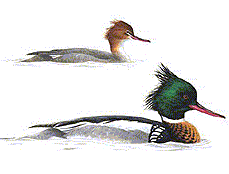 |
Slimmer and slightly smaller (52-58cm) than goosanders, males are easily identified by their fine red bill, obvious ragged crest at the back of the dark green head, white neck-band and orange-brown breast.
The red-headed female and immature birds are more tricky to separate from goosanders. They are always thin-billed, darker and generally more brown than 'redhead' goosanders, with a less contrasting division between dark head and pale neck, and a less well-defined white chin. They have a more obvious ragged crest and if seen closely the facial expression is different, with almost a 'smile' compared with the stern goosander.
In flight they look long with a rapid wingbeat and when flying close by, a humming noise from the wings can be heard. The drake has a white inner wing and the female has a smaller white patch.
Any of our creeks or rivers in winter can turn up good views of these birds. |
Reed Bunting (Emberiza schoeniclus)
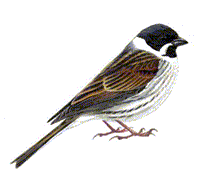 |
Sparrow-sized (15-16cm)but slim and with a long, deeply notched tail, typical of British buntings. In flight the tail looks black with broad, white edges. The male has a black head, white collar and a drooping moustache and the females have broad blackish stripes on the throat, dark brown cheeks and nape with a grey tone to the neck. The upper parts of both sexes are red/brown with darker streaking and the underparts are cream to white with thin brown striping. The wings are reddish with brown/black primaries and secondaries .
In winter plumage both sexes and the juveniles are very difficult to distinguish. As the buff tips of new head feathers wear away over the winter the handsome black and white pattern of the spring male is revealed.
Usually perches rather upright on a plant stem, with its tail at an angle or twisted to one side. The flight is low and jerky, it perches on top of reeds or plants, often jerks its tail and dives down when danger threatens. When flushed it may rise up quite high, before diving down into cover.
The song is repetitive series of staccato and squeaky notes: 'tweek, tweek, tweek, titititick' given from a perch on a reed or bush. Its most usual call is a characteristic 'seeoo'.
Try Wat Tyler Country Park or Wakering Stairs for sightings of the Reed Bunting. |
Skylark (Alauda arvensis)
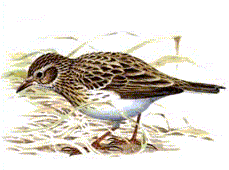 |
The skylark is a small brown bird (18-19cm), somewhat larger than a sparrow but smaller than a starling. It is streaky brown with a small crest, which can be raised when the bird is excited or alarmed, and a white-sided tail. The wings also have a white rear edge, visible in flight. It has a strong bill and a somewhat open-faced appearance due to a pale eye-ring. In flight over short distances it weaves and flutters with a loose hover before landing.
In song flight it is much more purposeful, rising almost vertically with rapid wing-beats, hovering for up to five minutes and then parachuting down. The male has a loud and melodious song but with a fairly restricted range of sounds. It will often give a slight 'trill' on take-off and then, at height, a continuous series of 'chirrup' or ' trruwee'. It has been know to mimic other birds and will also sing while on the ground.
Most suitable fields in spring will have Skylark. |
Sparrowhawk (Accipiter nisus)
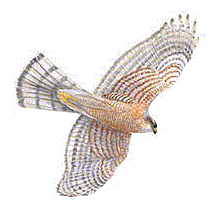 |
The male sparrowhawk (28-30cm) is one of the smallest British raptors, with short rounded wings (55cm wingspan) and long tail. It has a grey back, wings and tail with dark bars on the tail. It is white below, closely barred with orange, but appears deep orange at a distance.
The larger female (35-38cm; 70cm wingspan) has a dark brown back with dark-barred pale underparts. Tail has dark bars. When seen close to, females show a white supercilium which, combined with the bright yellow eye, gives them quite a stern look.
Juveniles look similar to females being brown above, but with a rufous wash which can be obvious in good light. The whitish underparts are spotted and blotched brownish forming ragged bars. Juveniles moult after about ten months into adult plumage.
The size difference between male and female is obvious at all ages with small males measuring 30cm in length and large females 40cm. Wingspan ranges from 55cm to 70cm. Females are about twice the weight of males and a large female can weigh up to three times a small male.
The commonest call is a harsh, chattering kek-kek-kek..
Can be seen anywhere at anytime. The Sparrowhawk hunts in gardens as well as in the open country. |
Spotted Flycatcher (Muscicapa striata)
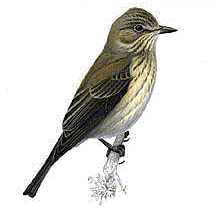 |
Adult spotted flycatchers are about 12-14 cm in length and lack any striking features. They are grey-brown in colour with an off-white breast, streaked with darker grey and a streaked forehead. Young birds are very spotted with pale brown on the back and head. They perch very upright on posts, wires and branches.
Spotted flycatchers are rarely seen on the ground but will occasionally hop to pick up food. Most often they frequently sit openly on branches making regular flights to catch insects, often returning to the same perch. When catching prey their beaks often make an audible snapping sound.
Thin, squeaky song and call which is distinctive but not very noticeable. When disturbed they have an insistent call - 'see tk-tk'.
Priory Park around the walled garden in spring would be the best place to look for this bird. |
Swallow (Hirundo rustica)
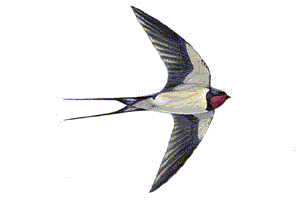 |
Swallows are traditionally a sign of summer, but they arrive well before summer does, with the earliest seen in late March. Most arrive during April, taking advantage of any southerly winds which will assist their long journeys from Africa.
It's easy to confuse swallows and martins, especially when they dart about in the sky together. You can tell swallows apart because of their very long tail streamers. Martins have much shorter forked tails. The longer a male swallow's tail streamers, the more chance he has of mating!
When swallows first return to the UK, they are constantly on the wing, hunting for insects and even drinking by swooping down over water and snatching a beakful. Your best chance of seeing a swallow really clearly is in September, when they sit together on telephone wires preparing to migrate back to Africa. When they sit still, you can see their red throats. |
Swift (Apus apus)
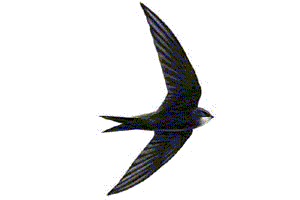 |
Swifts are one of the latest summer migrants to arrive in the UK. Small numbers arrive from mid April, especially along the south coast, but most arrive suddenly in early May. It seems amazing go to bed one evening with no swifts to be seen and then wake up the following morning to the screams of dozens overhead.
They are easily recognisable - larger than swallows or house martins, with all-dark plumage and long swept-back pointed wings which are best described as 'crescent-shaped'. They usually draw attention to themselves with their wild, screaming calls and dashing fast flight as they chase each other through the skies.
Their first few days may be spent feeding high in the sky before inspecting traditional nesting places inside the roofspaces of houses. Most gain access through a misplaced tile or gap in the eaves. |
Turtle Dove (Streptopelia turtur)
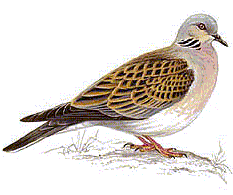 |
The turtle dove is a dainty dove, smaller (26-28cm) and darker than the collared dove and slightly larger than a blackbird. The upper parts are mottled chestnut and black. There are black and white striped patches on each side of the neck but no black collar. The wings are brown/red but the primaries are black. The breast is pink and the belly white. The tail is black and edged white, medium length and rounded. Its flight is characteristic, with flickering, jerky wingbeats, irregular short glides, sometimes tilting from side to side. It lands with a flurry of wings, tail fanned and showing broad white edges. The repetitive song is a distinctive, soothing 'turr turr....turr turr....'.
The telegraph wires alongside The Fleet in Wakering during the spring and summer would be the best place to look for this wonderful dove. |
All bird images and information is courtesy of the RSPB: www.rspb.org.uk
The A to Z of British Birds from the RSPB
Click here for details of the best places to see birds in the local area
Click here for our up to date local bird sightings
|






























